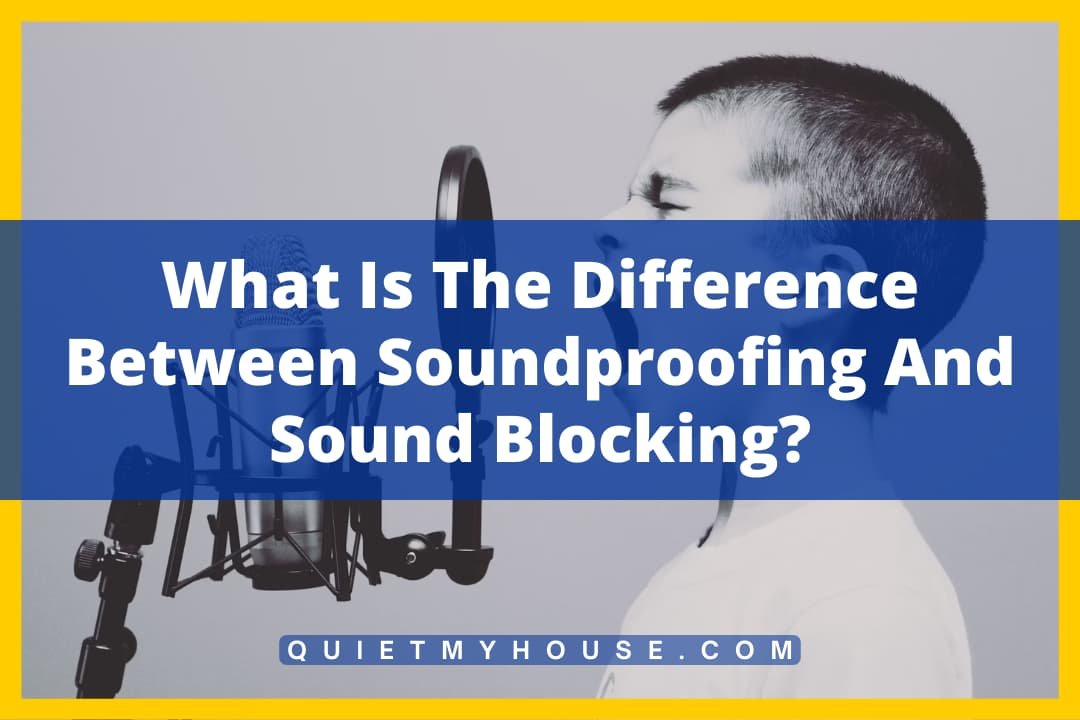Ever wondered how to transform your noisy room into a peaceful cocoon? Then you’ve probably encountered terms like ‘soundproofing’ and ‘sound blocking’. Both methods aim to restrict unwanted noise, but they follow completely different principles and applications.
In this article, you’re going to discover the distinction between soundproofing and sound blocking, giving you a clearer perspective to make informed decisions on which one to choose for your space. So, get ready to immerse yourself in the fascinating world of sounds and their control techniques.
Understanding the Basics
To understand the differences between soundproofing and sound blocking, it’s important to start with the basics of sound. Don’t worry, you won’t have to delve too deeply into the complexities of physics for this. Let’s get started!
Definition of Sound
Sound, in its simplest form, is the movement of vibrations through a medium, such as air or water. These vibrations enter your ears, where they are translated into what you understand as noises, music, speech, and more.
Sound plays a significant role in our daily lives, from the gentle hum of a computer to the faint murmurings of a distant conversation.
The Nature of Sound Waves
These vibrations are more formally referred to as sound waves. Unlike ocean waves, which move up and down, sound waves compress and expand the medium they’re passing through.
These waves move in a pattern, carrying the sound energy from one space to another, sometimes creating an unwanted intrusion of unsettling noise in a peaceful environment.
The Concept of Noise
This brings us to the concept of noise. Broadly speaking, noise is any undesired sound that can cause interference, disturbance and discomfort. What one person perceives as noise, however, may be perfectly acceptable sound to another, making it quite a subjective term.
The important point here is that sound can sometimes be a bother, and this brings in the need for its control, through methods such as soundproofing and sound blocking.
Defining Soundproofing
Soundproofing is a popular term, and you’ve probably heard of it if you’ve ever looked into creating a quiet room or space. But what precisely does it do?
Understanding Sound Reduction
Soundproofing is essentially about reducing the amplitude – or the “volume” – of sound waves. This process minimises the sound that’s able to pass from one area to another. In essence, soundproofing doesn’t completely block sound; instead, it simply lowers it to a more acceptable level.
Different Types of Soundproofing
There are several methods of soundproofing, each unique in its way. Some of these techniques include absorption of sound (using soft surfaces to absorb sound waves), sound damping (containing sound waves within a particular area), and sound decoupling (creating a gap that disrupts sound wave path).
Common Soundproofing Materials
Materials used in soundproofing are typically dense and thick to absorb and disrupt sound waves’ travels. They might include foam panels, insulation materials, soundproofing drywalls, or floor underlays, among others. Each has a role in managing sound energy.
How Soundproofing Works
Now that you have a basic understanding of what soundproofing is, let’s delve deeper into how it works.
Absorption of Sound Energy
The first process in soundproofing is the absorption of sound energy. This is where soft materials that we mentioned earlier come into play. They can absorb the energy of the sound waves hitting them, thereby reducing the amount of sound that gets through.
Sound Damping
The second process is sound damping. This involves converting the sound energy into another form of energy, such as a tiny amount of heat. As a result, the sound wave is dissipated and does not continue its path through the space, contributing to a quieter environment.
Sound Decoupling
Finally, we have sound decoupling. By creating a physical gap or break in the structure of a wall, floor, or ceiling, you disrupt the passage of sound waves. With no direct path to travel along, the majority of the sound energy is stopped dead in its tracks.
Applications of Soundproofing
Soundproofing is used in a wide variety of settings. Here are just a few.
Soundproofing in Buildings and Houses
Homes and buildings often utilise soundproofing techniques to lessen the noise transmitted between rooms or from exterior sources. It can bring a peaceful environment to houses beside busy roads or provide privacy in a crowded office.
Soundproofing in Transportation
Soundproofing is crucial in the transportation sector, especially in cars and planes. It helps to minimize the noise from outside, improving passengers’ comfort.
Soundproofing in Recording Studios
Recording studios need a quiet environment to capture clear, unadulterated audio. Hence, they employ extensive soundproofing methods to absorb, dampen, or decouple sound, ensuring outside noises don’t interfere with the recording process.

Defining Sound Blocking
Sound blocking, while similar in purpose to soundproofing, is distinct in how it reduces and controls sound.
Understanding Sound Isolation
Sound blocking aims at isolating – or separating – one space from another rather than merely reducing the amplitude of sound waves. It’s about stopping the sound from penetrating from one area to another.
Difference between Soundproofing and Sound Blocking
While soundproofing reduces the audible impact of sound waves, sound blocking aims at preventing sound from passing through a structure or material completely. For example, while soundproofing may make a conversation unintelligible, sound blocking would make it inaudible.
Materials Used for Sound Blocking
Blocking sound typically requires materials that are dense and mass-heavy. You might find lead-lined sheetrock or mass-loaded vinyl in a sound-blocking strategy. Each of these materials adds significant mass to a structure to prevent sound transmission.
How Sound Blocking Works
Just like soundproofing, sound blocking operates on a few basic principles.
Sound Deflection
Sound deflection is a key aspect of sound blocking. By creating a barrier or altering the structure using mass-heavy materials, you’re effectively bouncing off the sound waves, preventing them from passing through.
Mass and Density in Sound Blocking
In sound blocking, the mass and density of a structure or a material play a vital role. The denser a material, the more efficient it is at blocking sound due to its superior sound-reflecting ability.
Understanding Sound Transmission Class (STC)
Sound Transmission Class (STC) is a rating that represents the effectiveness of a building material at blocking sound. Higher STC ratings mean better sound blocking. It’s an important evaluation index when considering soundproofing or sound-blocking applications.

Applications of Sound Blocking
Sound blocking has a myriad of applications. Here are a few that are most common.
Sound Blocking in Theatres and Cinemas
Theatres and cinemas often employ sound blocking to keep outside sounds from disturbing the moviegoers and vice versa. This can be achieved through building isolations and heavy-duty walls and doors with high STC ratings.
Sound Blocking in Offices
In the office setting, sound-blocking techniques are used to create private spaces that allow for confidential conversations and focused work.
Sound Blocking in Vehicles
In vehicles, especially luxury automobiles, sound-blocking materials are used to create a supremely quiet ride, isolating the passengers from the roar of the engine and the noise of the road.
Comparing Soundproofing and Sound Blocking
Now that we’ve covered what each process entails, let’s compare the two to better understand their effectiveness, costs, and installation ease.
Effectiveness in Different Scenarios
Both soundproofing and sound blocking have their place depending on your requirements. If you’re looking to lessen the impact of the sound, soundproofing will be your best bet.
However, if you need to prevent the sound from travelling altogether, sound blocking should be the way to go.
Cost Comparison
The cost can vary significantly between soundproofing and sound blocking. Soundproofing materials like foam panels or insulation materials are relatively cheaper compared to sound-blocking materials like mass-loaded vinyl or lead-lined sheetrock.
Ease of Installation
Similarly, ease of installation can also depend heavily on the method chosen. Soundproofing, in general, is easier and less intrusive to install, making it suitable for existing buildings or rooms.
On the contrary, sound blocking often requires extensive construction work, making it better suited for new buildings or major renovations.
Choosing Between Soundproofing and Sound Blocking
Picking the right method for your needs can be a challenging decision. Here are some factors to remember.
Assessing Your Needs
Decide on what you want to achieve – lowering sound levels or creating a sound-isolation environment. This assessment will primarily dictate whether soundproofing or sound-blocking is the right method for you.
Considerations for Installation
Think about the practicality of installation. If you’re up for a major renovation, you can consider sound blocking; if not, soundproofing would be more feasible.
Long-Term Durability and Maintenance
Lastly, consider the durability and maintenance of each method. While some soundproofing methods might require regular maintenance, sound-blocking techniques can often last a lifetime without any major upkeep.
Future Developments in Sound Management
Looking ahead, soundproofing and sound-blocking technologies are continually evolving with the advancements in science and technology.
Advancements in Soundproofing Technologies
Several innovations are taking place in the world of soundproofing technologies, like the development of new materials that can absorb more sound and reduce noise levels even further.
Emerging Trends in Sound Blocking
Sounds blocking, too, is seeing its share of advancements, with materials being developed to provide even more effective sound isolation.
Impact of Technological Advances on Sound Management
All these new advancements and emerging trends promise to bring even better results in sound management in the future.
While we can’t predict the exact nature these technologies will take, we can be certain that they will continue to improve our ability to control and manage sound in our environments.
Remember, both soundproofing and sound blocking have their pros and cons, and choice must depend on your unique circumstances, needs and budget.
With this comprehensive guide, you’re now equipped to make an informed decision when it comes to sound management. Have a happy and peaceful existence!




